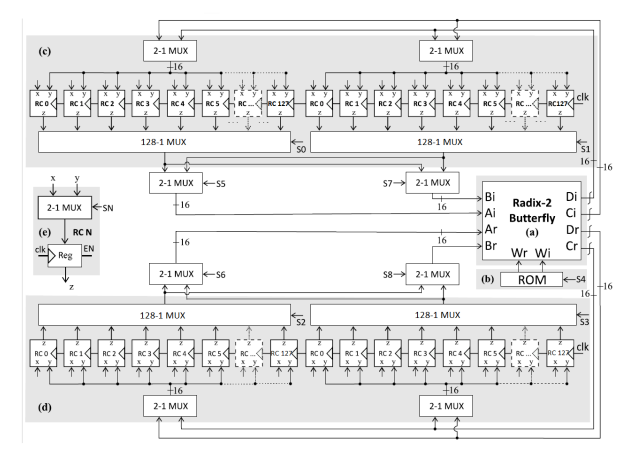Energy-Quality Scalable Design Space Exploration of Approximate FFT Hardware Architectures
Also Available Domains Xilinx Vivado|Xilinx ISE
Objective
This paper presents a comprehensive design space exploration for boosting energy efficiency of a fast Fourier transform (FFT) VLSI accelerator, exploiting several approximate multipliers (Ax M) combined with approximate adder (Ax A) circuits.
Abstract
This paper presents a comprehensive design space exploration for boosting energy efficiency of a fast Fourier transform (FFT) VLSI accelerator, exploiting several approximate multipliers (Ax M) combined with approximate adder (Ax A) circuits. The FFT hardware herein presented consists of a fixed-point sequential architecture using a radix-2 butterfly with decimation in time. We explore a set of Ax Ms – namely Dynamic Range Unbiased (DRUM), Rounding-based Approximate (Ro BA), leading one Bit-based Approximate (Lo BA), and Truncated approach – jointly with the LOA, ETA-I, Copy A, Copy B, Trunc0, Trunc1 approximate adders. The approximate arithmetic operators are used in the butterfly kernel with exploration of the approximation levels (for the L and K least-significant bits, respectively, for the Ax M and Ax A), aiming at discovering the most energy-efficient configuration under a design-time QoR constraint. The mean square error and peak signal-to-noise ratio metrics define which approximate levels combining L and K variations will enable the FFT to process signals to generate spectrograms without significant losses. Our results show that the Lo BA multiplier with L=8 together with the LOA, Trunc1 and Trunc0, at different approximation levels, provide most energy savings with controllable quality degradation, presenting a minimum decrease of 20.2% in power dissipation without degrading the spectrogram generation quality.
NOTE: Without the concern of our team, please don't submit to the college. This Abstract varies based on student requirements.
Block Diagram

Specifications
Software Requirements:
· Tool: Xilinx ISE 14.7/ XilinxVivado2018.3
· HDL: Verilog
Hardware Requirements:
· Microsoft® Windows XP
· Intel® Pentium® 4 processor or Pentium 4 equivalent with SSE support
· 512 MB RAM
· 100 MB of available disk space
Learning Outcomes
- Basics of Digital Electronics
- VLSI design Flow
- Introduction to Verilog Coding
- Different modeling styles in Verilog
o Data Flow modeling
o Structural modeling
o Behavioral modeling
o Mixed level modeling
- Introduction to Fourier Transform
- Knowledge on Discrete Fourier Transform and Fast Fourier Transform
- Different multipliers such as complex multiplier and constant multipliers
- Knowledge on energy quality scalable
- Applications in real time
- Xilinx ISE 14.7/Xilinx Vivado2018.3 for design and simulation
- Generation of Netlist
- Solution providing for real time problems
- Project Development Skills:
o Problem Analysis Skills
o Problem Solving Skills
o Logical Skills
o Designing Skills
o Testing Skills
o Debugging Skills
o Presentation Skills
o Thesis Writing Skills





 Paper Publishing
Paper Publishing
